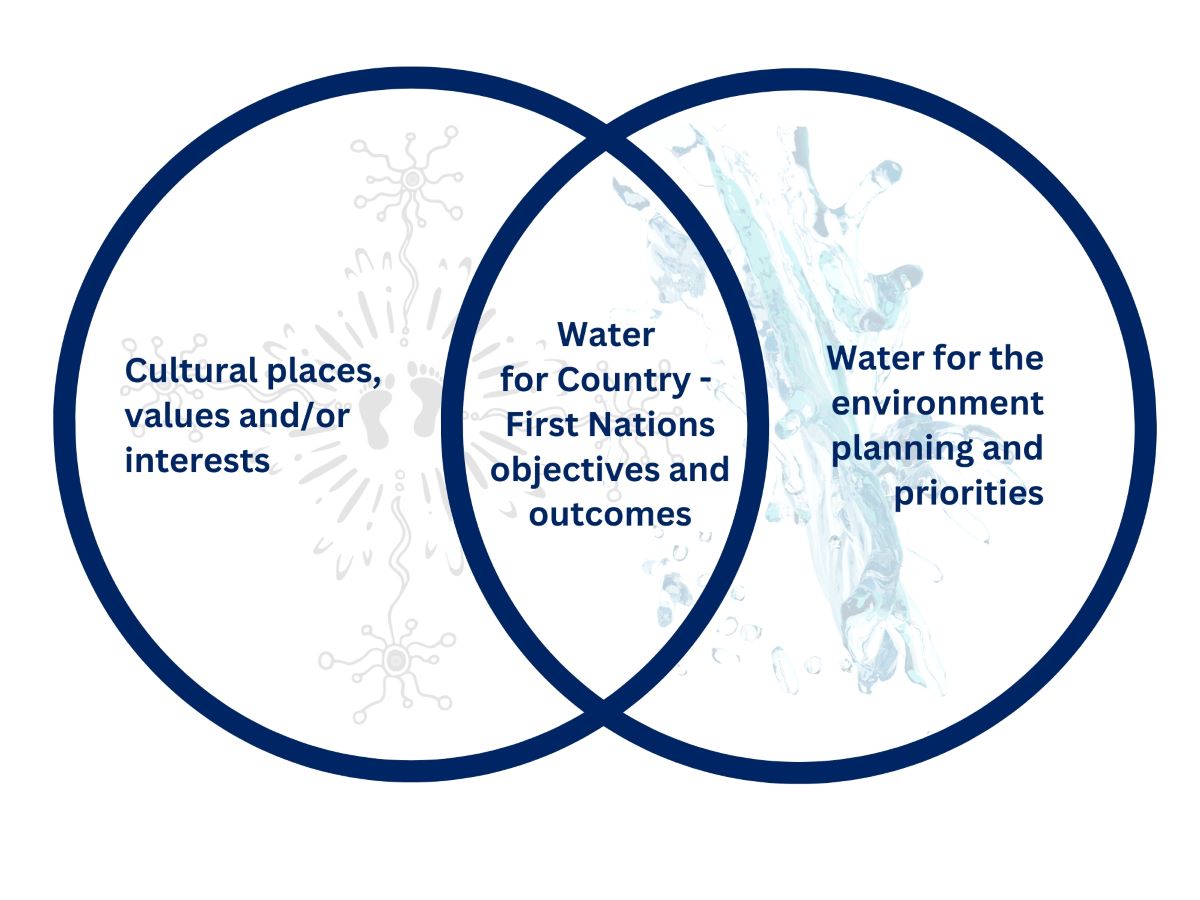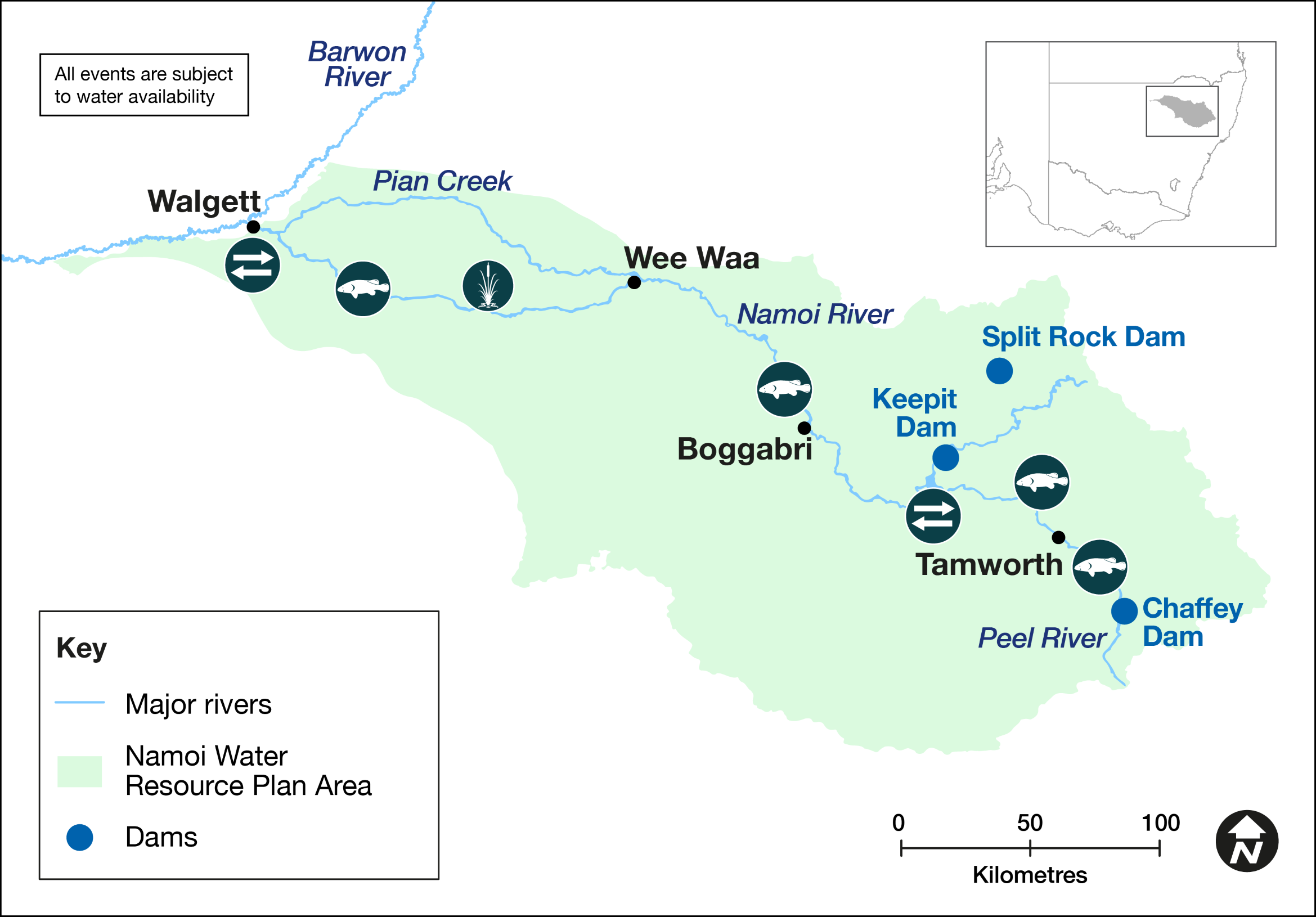Water that is allocated and managed specifically to improve the health of rivers, wetlands and floodplains is known as water for the environment.
NSW environmental water management teams work with local communities, Aboriginal representatives, partner agencies, and other stakeholders to develop detailed annual plans for the use of water for the environment in each catchment, including how its use is prioritised.
The catchment
The Namoi catchment covers an area of approximately 42,000 km2. The Namoi and Peel rivers are regulated, with major water storages being Keepit– Split Rock and Chaffey dams. Significant environmental values in the catchment include the Namoi River between Gunnedah and Narrabri which provides critical habitat for native fish and threatened species.
Also, many small lagoons, wetlands and anabranches on the floodplain downstream of Narrabri provide habitat for waterbirds. Lake Goran, in the unregulated Mooki catchment, is listed as a wetland of national significance.
The Namoi catchment wetlands and rivers also support important Aboriginal cultural values for the Gomeroi/Kamilaroi Aboriginal people.
Water for rivers and wetlands
Following wetter conditions in 2020 and 2021, natural river flows, and large-scale floods continued in 2022–23. No water for the environment was delivered during the year as dam spills, combined with inflows from downstream tributaries, provided for environmental demands in the Lower Namoi and Peel rivers. Large flows reached the end of the Namoi system, contributing to environmental water needs in the Barwon–Darling River.
As we move into El Nino conditions, water managers will monitor catchment conditions to determine the most appropriate use of water for the environment. In the year ahead, it is likely water managers will continue to support native fish recovery, particularly below Wee Waa, by providing flows that support their movement and dispersal opportunities in the system.
Management of water for the environment in the Peel catchment will continue to focus on in-channel productivity, habitat quality and native fish population recovery upstream of Tamworth. Water managers will likely deliver flows in spring and autumn.
With a healthy general security account balance in the Namoi as of 1 July 2023, water managers can plan to support resilience moving into a potentially dry period by holding water in the general security carryover account.
Aboriginal water management priorities
Water for Country is environmental water use planned by the Department of Climate Change, Energy, the Environment and Water and Aboriginal people to achieve shared benefits for the environment and cultural places, values and/or interests.
The Namoi is home to Kamilaroi people. Water managers and Aboriginal people are dedicated to building relationships and sharing knowledge on the ecological and cultural values of the river and its floodplain. Water managers will continue to support Aboriginal representatives by including their priorities in annual water planning processes.
Plans are in motion to formalise the Namoi–Peel Environmental Water Advisory Group. This community-driven process, which includes Aboriginal representation, will lead to shared benefits for cultural and environmental outcomes.
In addition, water managers will participate in a project led by Department of Primary Industries, Fisheries, which aims to include cultural knowledge, experience and perspectives in the fish and flows framework to develop flow-related cultural objectives in support of fish conservation.

Environmental water managers have been working to support Aboriginal people’s priorities in water management.
Weather and water forecast
As at early June the El Niño–Southern Oscillation (ENSO1) outlook is neutral, with an El Niño watch. There is a 50% chance that an El Niño may develop later in 2023. This is about twice the normal likelihood.
The short-term rainfall outlook is likely to be above median for the Namoi which will maintain the current soil moisture and run-off efficiency within the catchment.
Water managers have prepared watering plans that consider a range of weather and water availability scenarios. This is known as resource availability scenario planning. As dam levels remain high, a degree of uncertainty remains around resource availability. However, on balance, the Namoi catchment outlook is rated as 'wet'.
1. ENSO: The interaction between the sea surface and atmosphere over the Pacific Ocean which results in dryer (El Nino) or wetter (La Nina) conditions.
Resource availability scenario
Current forecast: Wet to very wet
| Conditions | Main aim | Other aims |
|---|---|---|
| Very dry | Protect | Avoid critical loss Maintain key refuges Avoid catastrophic events |
| Dry | Maintain | Maintain river functioning Maintain key functions of high priority wetlands |
| Moderate | Recover | Improve ecological health and resilience Improve opportunities for plants and animals to breed, move and thrive |
| Wet to very wet | Enhance | Restore key floodplain and wetland linkages Enhance opportunities for plants and animals to breed, move and thrive |
Key planned actions for 2023–24
It is likely water managers will aim to provide a small fresh in the Peel River above Tamworth during spring. Depending on river and forecast rainfall conditions in autumn, a further smaller release may be delivered to prepare the river before traditionally low flows over the winter period.
The Lower Namoi may also see water delivered in spring to support river productivity and native fish outcomes.
Improving river productivity will be the primary focus for water managers in the upland Peel River. This will involve providing flows that inundate in-channel bars and benches to return built-up organic matter to support the aquatic food web. The more food made, the healthier and more productive our river ecosystem becomes.
Native fish
Water managers will look for opportunities to help support movement and breeding for small and medium bodied native fish in the Peel and Lower Namoi rivers.
They may also consider flows to support refuge habitat and small-scale movement opportunities below Wee Waa during autumn as regulated river flows reduce or cease.
Connectivity
Water managers will look for opportunities to provide connection along the Namoi River and between the Namoi and Barwon rivers to encourage dispersal of native fish into the Namoi River system.
Map of proposed annual priority targets in the water resource plan area 2023–24

Map of the Namoi catchment area showing priority targets for environmental water to be delivered to in 2023–24
The Department of Climate Change, Energy, the Environment and Water is supporting the health and resilience of rivers and wetlands by delivering water for the environment where and when it is needed. We use the best available science, management expertise and experience to manage water across the landscape. This statement of annual priorities identifies the waterways and wetlands that are likely to receive water.
Our decision-making process considers:
- expected availability of water in the coming year
- conditions of the previous year
- current health of the plants and animals in these ecosystems.
Water for the environment delivers benefits for communities, rivers, wetlands and wildlife across New South Wales.
Healthy, connected rivers and floodplains are a focus for tourism, fishing, recreation and relaxation. Rivers carry water to our homes, schools, farms and businesses, and along the way, support countless species including native fish, waterbirds, frogs, plants and more.
Rivers and wetlands have great cultural and spiritual significance for Aboriginal people.
Water for the environment is a critical tool to maintain and enhance the rivers, wetlands and wildlife we all love.
Working with communities
Local communities are at the heart of everything we do.
We involve the broader community by holding site tours and forums, and online and in-person events.
In catchments that have community-based environmental water advisory groups, NSW water management teams consult with them regularly.
Environmental water advisory group members include local landholders, recreational fishers, Aboriginal people and local government representatives. Their advice helps to inform the decisions made by our local environmental water management teams.
The Namoi catchment doesn’t currently have an environmental water advisory group, but the department is in the process of developing one.
Expected environmental water volumes available at 1 July 2023
The Department of Climate Change, Energy, the Environment and Water works with partner agencies to manage environmental water in the catchment.
Planned environmental water
| Source | Maximum volume available (megalitres) | Volume expected 1 July under current conditions (megalitres) |
|---|---|---|
| Environmental Water Allowance | 5,000 | 3,350 |
Peel water licenced to the Commonwealth
| Source | Maximum volume available (megalitres) | Volume expected 1 July under current conditions (megalitres) |
|---|---|---|
| General security | 1,257 | 842 |
Upper Namoi licenced to the Commonwealth
| Source | Maximum volume available (megalitres) | Volume expected 1 July under current conditions (megalitres) |
|---|---|---|
| General security | 105 | 105 |
Lower Namoi licenced to the Commonwealth
| Source | Maximum volume available (megalitres) | Volume expected 1 July under current conditions (megalitres) |
|---|---|---|
| General security | 13,548 | 27,201 |
Notes: This is an indicative summary of expected volumes to be available. For further detail and information on available volumes you can contact the region via the Department of Climate Change, Energy, the Environment and Water on 1300 361 967.
1 gigalitre = 1000 megalitres; 2.5 megalitre = 1 Olympic swimming pool.
Outcomes of water for the environment
Water for the environment has been delivering outcomes for rivers, wetlands and wildlife for 30 years.
We deliver flows that:
- trigger native fish to breed and move
- support waterbirds to nest and feed
- connect rivers and floodplains
- water forests and floodplains
- allow plants to grow, flower and set seed
- create refuge during droughts
- enhance outcomes during wetter times
- release vital nutrients from the floodplain floor that underpin the aquatic food web.
It's habitat restoration on a landscape scale.

The junction of the Namoi and Barwon rivers
More information on planned and past watering events
- Annual environmental water priorities in the Namoi catchment 2022–23
- Namoi Catchment – Water for the Environment: Annual Priorities 2021–22
- Namoi: Annual environmental watering priorities 2019–20
- Water for environment outcomes 2022–23
- Water for environment outcomes 2021–22
- Use of water for the environment in NSW: Outcomes 2020–21
- Use of water for the environment in NSW: Outcomes 2019–20
- Use of water for the environment in NSW: Outcomes 2018–19